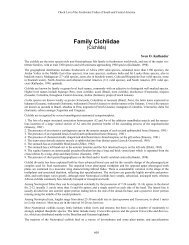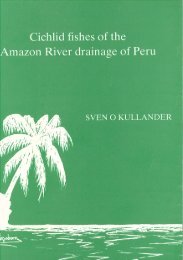Open Access PDF - Sven Kullander
Open Access PDF - Sven Kullander
Open Access PDF - Sven Kullander
Create successful ePaper yourself
Turn your PDF publications into a flip-book with our unique Google optimized e-Paper software.
366<br />
intense on lower head side, turning greenish<br />
dorsally and on caudal peduncle, ventral parts<br />
white. Iris yellowish. Bars or blotches black, ocellar<br />
margins white. Branchiostegal membrane may<br />
be orange and lower half of caudal fin as well as<br />
anal fin may be yellowish. Nuchal hump dark<br />
grey in specimens showing this feature (Fig. 72).<br />
Geographical distribution. Lower Rio Tapajós,<br />
Rio Curuá-Una, lower Rio Xingu, lower Rio Tocantins,<br />
and Rio Capim (Fig. 75); uncertain localities<br />
in southern Amapá and Rio Arapiuns,<br />
introduced in Rio Paraguaçu in eastern Brazil,<br />
and probably elsewhere in northeastern Brazil.<br />
Etymology. The species epithet pinima is a Tupi-<br />
Guarani adjective meaning spotted with white,<br />
and is here used as a noun in apposition.<br />
Local names. We propose tucunaré pinima as<br />
Brazilian name for this species, selecting a name<br />
already in use.<br />
Notes. Tucunaré pinima is applied as a local<br />
name on the current species at least in the Nordeste<br />
region of Brazil, where it forms self-sustaining<br />
stocks following introductions into numerous<br />
reservoirs in the 1940s (Fontenele, 1948; Braga,<br />
1952, 1953; Menezes, 1953; Bezerra e Silva et al.,<br />
1980; as C. temensis). According to Menezes (1953:<br />
382-383) tucunaré pinima was the name used<br />
locally by the Serviço de Piscicultura in Fortaleza<br />
(Ceará) for the species sent there by Museu Goeldi<br />
as tucunaré-açu. Santos et al. (1985), in a catalog<br />
of fishes from the Tucurui dam, illustrate the<br />
adult as C. ocellaris, tucunaré-açu, and the young<br />
as C. temensis, tucunaré-pinima. Nomura (1984:<br />
454-455) included tucunaré-pinima as a synonym<br />
of tucunaré-açu as well as tucunaré-tinga, identified<br />
as C. temensis, and identified tucunaré-comum<br />
as C. ocellaris. His illustration of C. ocellaris<br />
is a reproduction of Spix & Agassiz’s (1831: pl.<br />
63) illustration of C. monoculus. Santos (1981:156)<br />
uses the vernacular tucunaré putanga, referring<br />
to a lecture by Carlos Estevão (then director of<br />
the Museu Goeldi in Belém) at the Rotary Clube<br />
do Pará, and indicating that it would have been<br />
reproduced also in Ceará, but is possibly not his<br />
species.<br />
Sawaya (1946) conducted experiments on<br />
Cichla and Astronotus in ponds in Museu Goeldi<br />
and reported on tucunaré putanga as well as a<br />
hybrid C. temensis × C. ocellaris, but without clues<br />
to their identity. Sawaya & Maranhão (1946) reported<br />
on tucunaré açú (Cichla ocellaris), tucunaré<br />
putanga (species not yet well determined), tucunaré<br />
tinga (C. temensis) and the ‘hybrid’. Sawaya<br />
& Maranhão (1946) considered the putanga to be<br />
more elongate than the tucunaré-açu, with more<br />
elongate head and smaller interorbital space. The<br />
lateral line is said to be broken in the young and<br />
never turning entire in the adults. The small whitish<br />
spots would always be absent, in adults as<br />
well as juveniles. There is no further information<br />
from Museu Goeldi or elsewhere on the putanga.<br />
There is a possibility that the name putanga, of<br />
unknown meaning, resulted from a misunderstanding<br />
or misapplication involving the names<br />
pinima and tinga.<br />
There seems to have been considerable confusion<br />
over what species was being studied in<br />
Museu Goeldi as well as in the fisheries station<br />
at Fortaleza. For certain, C. pinima was studied in<br />
Ceará, as evidenced by photos and illustrations<br />
in Braga (1953), Fontenele (1948) and Bezerra e<br />
Silva et al. (1980). Also C. kelberi, identified as<br />
C. ocellaris (tucunaré comum) by Fontenele (1948),<br />
was cultivated. Three specimens that we refer to<br />
C. pinima, MZUSP 50273, 177-288 mm SL, labeled<br />
Museu Goeldi, have an aspect indicating stunted<br />
growth. They have deeper head, deeper body,<br />
longer pectoral fin, and larger eye than other<br />
C. pinima of similar length, and separate from a<br />
cluster formed by the other species in a morphometric<br />
canonical discriminant analysis (not shown).<br />
They also have relatively low E1 scale counts (78,<br />
84, 88). We thus excluded those specimens from<br />
the morphometric analysis, although the colour<br />
pattern agrees with C. pinima.<br />
Cichla pinima is widely distributed, and there<br />
are large, well preserved series chiefly from the<br />
lower Rio Tapajós drainage supplemented by well<br />
preserved material from the lower Rio Xingu. The<br />
species is characterized by the early appearance,<br />
below 100 mm SL, of a blackish, more or less<br />
ocellated blotch dorsally in bar 3, close to the<br />
dorsal fin base. In large males this blotch is increased<br />
in size and highly prominent, but then<br />
similar in appearance to the corresponding blotch<br />
in several other Cichla species. In C. vazzoleri, there<br />
is no ocellated blotch close to the dorsal fin except<br />
in large adults (about 300 mm and larger). In adult<br />
C. vazzoleri, C. jariina, and C. thyrorus is typically<br />
present a dark brown or black blotch at the anterodorsal<br />
process of the subopercle, usually<br />
absent in C. pinima.<br />
<strong>Kullander</strong> & Ferreira: Review of Cichla




